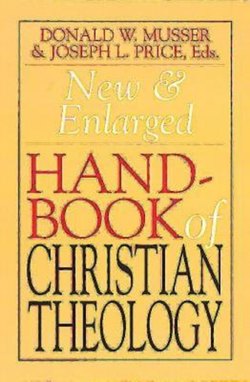Читать книгу New & Enlarged Handbook of Christian Theology - Donald W. Musser - Страница 22
На сайте Литреса книга снята с продажи.
ОглавлениеATONEMENT
Atonement (“atonement,” a sixteenth-century coinage) is the reconciliation of sinners with God, especially through the cross, as communicated through the gospel and the sacraments. The cross is proclaimed as somehow resolving the human predicament; but the predicament and its resolution can be understood in quite different ways. Is the problem in humans’ relation to the powers of evil, in their relation to God, or within themselves?
1. The patristic emphasis was on the first of these, the powers of evil. If human beings are in bondage to the devil (collectively the “powers of evil”), then they must be redeemed by paying a “ransom.” But how? to whom? by what? In using the metaphor of the devil’s being lured by the bait of Christ’s humanity, patristic writers suggested that the powers of evil overstepped their authority and discredited themselves. Although the powers of evil may have had a legitimate claim over sinners, who had yielded to temptation and were bound by guilt, they did not have the same claim over Christ, who, after identifying himself with sinners and captives, and being accused and executed as though he were a sinner, was vindicated by God in his resurrection. Thus, all those who attach themselves to Christ through faith and baptism are freed from the devil. In this way patristic theologians considered that Christ provided a ransom for humans’ sins and bondage to evil.
Although this “ransom” motif is often despised as crass and mythological, it manifests some of the processes of scapegoating and victimization of which liberation movements have made us newly aware. Liberation theology concerns domination by the powers of evil, whose claim is expressed in “structures of evil” and enforced through a combination of guilt and fear. In liberation the framework of legalism (which can be “just” as well as oppressive) is not simply abolished; rather, it is brought to defeat itself in its very administration. Through inflicting undeserved suffering the powers of domination are unmasked and discredited, losing moral authority in the forum of public opinion. The captives are not only freed from moral and psychological bondage but are empowered for a new mode of life.
2. Atonement as a change in the human relationship to God is present in New Testament and patristic thought, especially in the motif of sacrifice, either as “expiating” human sins or as “propitiating” God’s anger, but it was not developed into a theory until the medieval and Reformation periods.
Anselm’s Cur Deus Homo set the stage by thinking of God on the model of the feudal overlord whose honor is offended by sinful humanity. God’s justice requires either punishment (involuntary suffering and damnation) or satisfaction (making up for the offense through voluntary suffering, a model for which was at hand in the practice of penance). In keeping with the second possibility, satisfaction is offered by Christ as God-human, whose acts are not only sinless, but of infinite merit.
The Reformers shifted the focus from God’s honor, which can be satisfied through penitential sacrifice, to God’s wrath, which seems rather to demand punishment. Thus Christ is viewed as the “substitute” for sinful humanity, bearing the full force of God’s wrath and rejection on the cross.
Because this theory involves an “exchange” between a sinful humanity, which deserves God’s condemnation, and the sinless Christ, who enacts God’s love, it seems to introduce a division, or at least a tension, into God. Salvation, to be sure, is initiated by God, in order to accomplish God’s initial purposes for creation; but it is presented as resolving a problem “within God,” as though the Son must satisfy the conditions of divine justice, or even propitiate the Father’s wrath, in order that sinners be forgiven or justified.
All theories of this type, furthermore, view suffering, and even punishment, as salvific—an assumption that has been questioned on moral and psychological grounds, most recently by liberation and feminist theologians who see it as a reinforcement of domination and abuse. And yet in today’s theology the cross is often linked with a wider divine suffering and identification with those who suffer in order to overcome evil. Which kind of suffering must be rejected, and which can be accepted?
3. Atonement as a change within human being is linked with Peter Abelard in the eleventh century and with modern liberal theology. Here the cross is viewed as the expression of God’s forgiving love for sinful humanity, even in the face of human rebellion and violence toward its bearer. Because the goal is understood to be a change in human attitude and mode of life, this theory is called the “moral influence” theory—a term often misunderstood, for it means not “merely” moral or exemplary, but influencing the inmost affections through an appeal that is consciously apprehended. The emphasis is upon the dynamics of human subjectivity, human possibilities for growth, and the transforming role of interpersonal relations.
If there is a current trend, it is away from insistence upon a single metaphor for atonement and the conceptual framework that seems to grow from it, and toward appreciation of the variety of images, each of which suggests something important about divine initiative, human response, and continuing obstacles to the renewal of life.
EUGENE TESELLE
Bibliography
Joanne Carlson Brown and Carole R. Bohn, eds., Christianity, Patriarchy, and Abuse: A Feminist Critique.
Dennis Edwards, What Are They Saying About Salvation?
Paul S. Fiddes, Past Event and Present Salvation: The Christian Idea of Atonement.
Robert S. Franks, The Work of Christ: A Historical Study of Christian Doctrine.
Colin E. Gunton, The Actuality of Atonement: A Study of Metaphor, Rationality, and the Christian Tradition.
Walter Wink, The Powers, 3 volumes.
Cross-Reference: Anthropology, Christology, Evil, Justification, Sin, Soteriology, Suffering.
